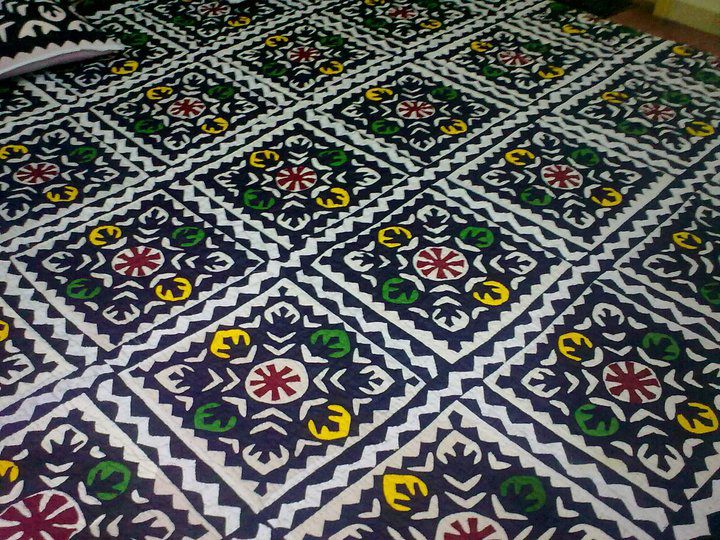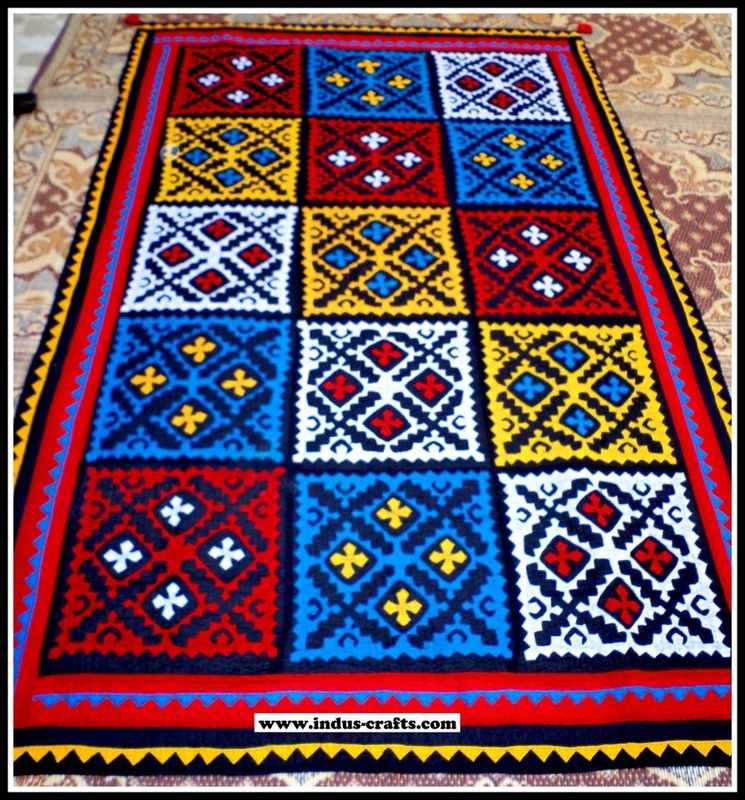Ralli quilts are traditional quilts made by women in the areas of Sindh and in surrounding areas. They are just now gaining international recognition, even though women have been making these quilts for hundreds, maybe thousands of years. Rallis are a cultural symbol for the regions where they are made. The most common uses are for a single person sized bedcover (used on the traditional wooden charpoy bed) or as small bag or eating cloth. Traditionally rallis were made at home, from recycled and hand dyed cotton cloth, for use by the family. Now there is some commercial production of rallis as colourful quilts, table runners and cushions and pillows.
The rallis come in three categories of design: patchwork, appliqué, and embroidery. Patchwork is the most common and is found on most village beds. Many of the designs are very complex. The designs are not written down but are held in the women's memories and are passed down from mother to daughter
Applique designs are also found throughout the ralli region. Small squares of fabric are cut out (similar to a paper "snowflake"), edges are turned under and sewn unto the block fabric.
Embroidery quilts are the speciality of a few nomadic groups in sindh and some parts of punjab and balochistan. These quilts generally use a large piece of whole or patched cloth and using colored thread, have stitching in embroidery designs go through all the layers of the cloth.
Many regions and communities have their own special colors and patterns in their rallis. The traditional colors of rallis are called "satrangi" or seven colors. The people of Thar in sindh like this one. They make them for their own use,for giving others as gift and for selling them to earn living.
Rallis are made with only fabric, thread, needles and scissors. The top of the quilt (the decorated portion) is usually the work of one woman. She generally will work on the blocks as she gets time between the chores of the day. When the top portion is all pieced and sewn together, she will start to sew it together. A reed mat is placed on the ground. The cloth that is to be the back or bottom of the quilt is placed on the mat. On top of that is placed small scraps of fabric (usually 3-5 layers) that will be the filling of the quilt. These are basted to the bottom with large stitches. The top fabric is then positioned and it is sewn to the pieces starting from the outside edges. Often a group of women will work on sewing a quilt together (much like the western "quilting bee"). The stitches are often very close together (1/8-1/2 inch apart)in long parallel lines extending the length of the quilt.
Sometimes it is possible to know where a ralli is made purely by its design. In the southern part of Sindh (lower), the region of Badin is famous for intricate quilts made in a black, white, red and yellow color scheme.

In middle Sindh, there are many variations in ralli design. The color scheme often includes white, black, red, yellow, orange, green, blue, purple.

In upper (northern) Sindh, they are famous for intricate blocks of appliqué (and sometimes embroidery) using many colors. The appliqué shapes often have other colors inserted in the openings. Multiple borders with many different designs are also used. They frequently put tassel borders in the corners or around the entire quilt. The older quilts have more subdued colors that have faded with time.
In southern Punjab (north of Sindh), the rallis have some very distinctive characteristics. In the area of Rahim Yar Khan, the ralli most commonly seen are a mix of 9 path blocks with very fine lined appliqué blocks. The border used frequently is squares on point and the backs are often orange
some designers have started introducing ralli work in their dresses also. And now its gaining access to people, now they would have it not only in their quilts but their dresses would also manifest this art.

Ralli or patchwork cushions are also very popular among people. they like to have them in their lounge to give an artistic look to their home decoration.
Ralli art in table runners
Beautiful ralli work bedsheets
Traditional ralliwork handbags
In the past decade, rallis have gained much popularity and notice. Articles about rallis have appeared in many popular American quilting magazines and other publications. Rallis have been exhibited for the first time in several quilt museums in the US with the first exhibit at the International Quilt Festival in Houston in 2003. Now the International Quilt Study Center at the University of Nebraska-Lincoln has a growing collection of about 150 rallis. Rallis were in the news as a result of the terrible flooding in Pakistan in August 2010. Many people escaped the floods with only their families and their rallis. Women in the refugee camps used their time to make more rallis to use or to sell.
No comments:
Post a Comment